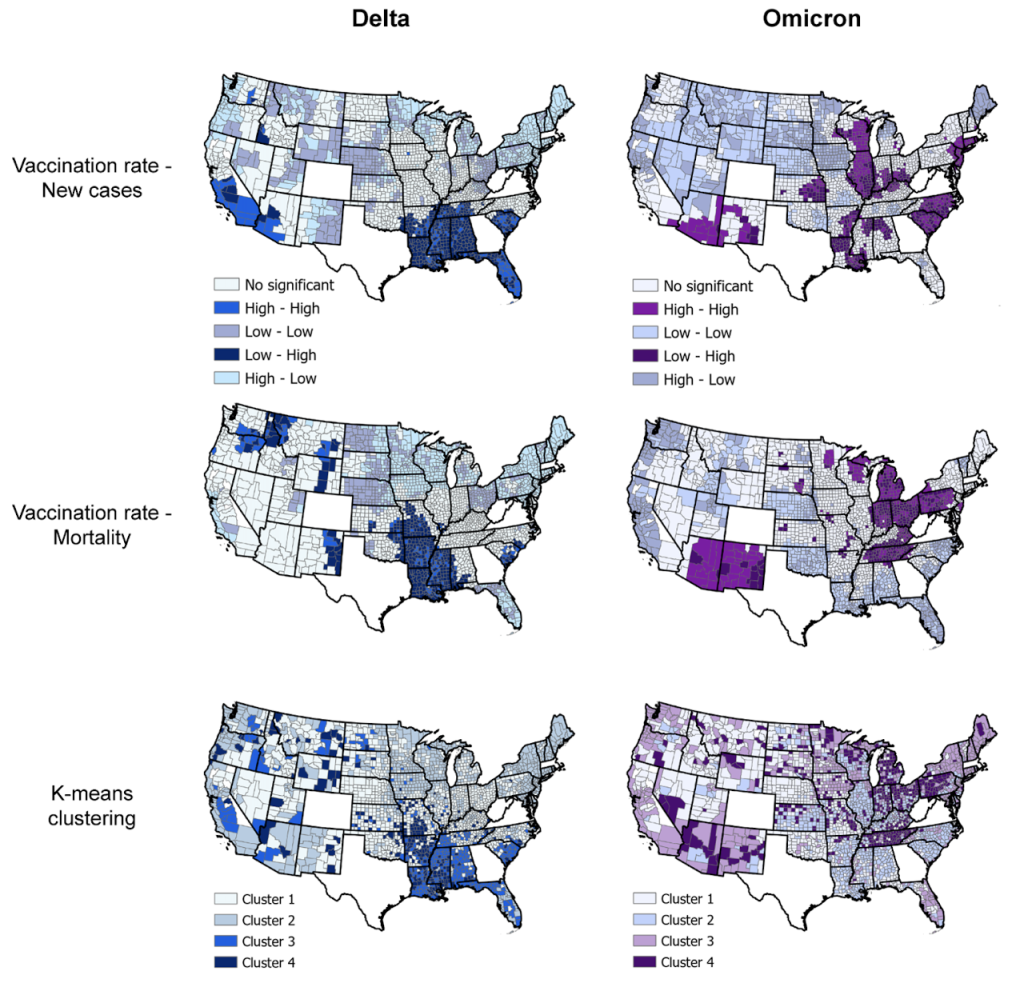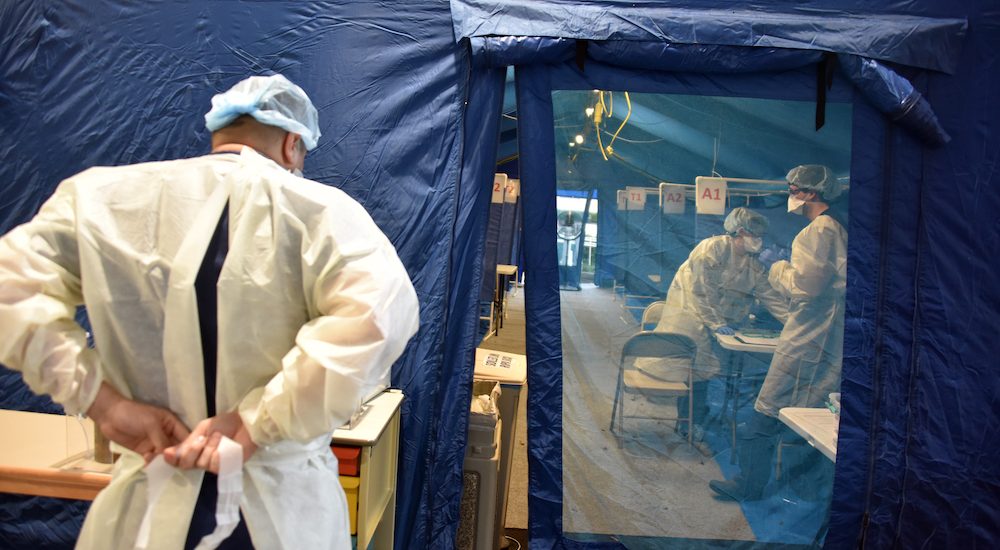A new study co-authored by two Augusta University researchers revealed stark disparities in health care between urban and rural America during the omicron wave of the COVID-19 pandemic in late 2021 and early 2022.
The study, which was published June 14 by the scientific journal Frontiers in Medicine, was led by Dr. Diego Cuadros, director of the University of Cincinnati’s Digital Epidemiology Lab. Augusta University’s Dr. Neil J. MacKinnon, provost and executive vice president for academic affairs, and Dr. Phillip Coule, associate dean of the Medical College of Georgia at Augusta University and chief medical officer at Augusta University Health System, were co-authors of the study.

“This new national study, looking back at the delta and omicron variants of COVID-19, demonstrates the power and utility of geospatial and data visualization analysis,” said MacKinnon, who previously served as dean of UC’s James L. Winkle College of Pharmacy.
“It is our hope this information might be useful for decision-makers for future public health campaigns and approaches to address pandemics.”
During the latter part of 2021 and early 2022, the United States suffered the fourth and most severe wave of the COVID-19 pandemic driven by the SARS-CoV-2 omicron.
The omicron variant proved to be highly transmissible and even infected those who were vaccinated, but even so, vaccination coverage disparities have shaped the epidemic dynamics in a major way.
“Omicron spread like crazy. The daily peak of omicron infections was three times higher than the peak of delta,” Cuadros said.
“The epicenter of the omicron wave was concentrated in densely populated, urban counties. But while cases exploded, infections did not lead to the same dire rate of deaths and hospitalizations as previous variants like delta. Delta was less infectious but more deadly than omicron,” Cuadros said.

The study found that during the omicron wave, areas with a high vaccination rate (greater than 60%) experienced a 1.4 times higher COVID-19 incidence rate (95% confidence interval 1.3-1.7) compared with low-vaccinated areas (less than 40%).
However, the mortality rate was 1.6 times higher (95% CI 1.5-1.7) in lower-vaccinated areas in contrast to higher-vaccinated areas. This resulted in a 2.2 times higher (95% CI 2.1-2.2) case-fatality ratio. Geospatial clustering analysis showed a more defined spatial structure during the delta wave with clusters with low vaccination rates and high incidence and mortality located in southern states.

The conclusion of the study was that despite the emergence of new variants of the COVID-19 virus with different transmission potentials, vaccines make a positive difference in the outcomes of patient survival with low-vaccinated areas having the largest COVID-19 related mortality during the delta and omicron waves in the U.S. Vulnerable communities residing in low-vaccinated areas, which tend to be mostly rural areas, are suffering the highest burden of the COVID-19 pandemic during the vaccination era.
“This study adds compelling evidence of the impact of vaccination in reducing mortality from COVID-19 as well as additional data to support that COVID-19 did not impact all communities equally — something that must be considered in the evaluation of outcomes at the national level,” Coule said.
Researchers worry that rural America will face a disproportionate long-term impact from chronic or lingering symptoms known as long COVID-19.
“We’re talking about an extra burden that rural counties face. They face a higher probability of developing chronic illness from long COVID,” said co-author Claudia Moreno, assistant professor of physiology and biophysics at the University of Washington.
Meanwhile, the ability to track the disease has diminished as fewer people report new cases, which makes it harder for communities to assess their daily risk, Moreno said.
“In the early part of the pandemic, people knew exactly what the infection rates in their counties were day to day — like the weather,” Moreno said. “And now we have peaks in case loads that are so much higher, but there is less public awareness.”
Rural populations are older, which also makes them more vulnerable to COVID-19-related hospitalization and death. Rural America also has fewer doctors and less access to intensive care or ventilators, which are needed to treat complications from COVID-19 infections.
“Rural communities often face many challenges that exacerbate health disparities in the country,” the study concluded. “These areas usually run short on resources, including limited cold chain vaccine storage facilities and health care workers to administer vaccines. The geography can also compound disparities in access that affect rural clinics, which face unique challenges to provide vaccinations to residents who live many miles away.”
Moreno said many people, including herself, know someone who has died from COVID-19. Her cousin’s husband, a basketball coach, died despite his seemingly good health.
“It was devastating to my family,” she said. “That’s why my research has a personal motivation to help the community. You don’t want more families to experience that unnecessary pain.
“Many of us are getting COVID again and it’s mild,” Moreno said. “But we have to remember the people who died from this disease.”
Researchers say vaccination remains paramount to protect people as the pandemic persists.
“That’s why it’s important to tell people they need to get vaccinated,” Moreno said. “Vaccines work. They’re really helping people prevent death and health complications.”
Cuadros said disparities the study observed have implications far beyond the pandemic.
“COVID-19 exposed all of these hidden problems in our health care system,” Cuadros said. He has studied the impact of diseases such as AIDS and malaria in developing countries around the world. Ready access to health care makes all the difference, he said.
“We think of the United States as being a rich country with a good health care system, but it’s not true,” he said. “It’s strong in some areas with other areas that are vulnerable with poor access to health care.
“The disparities in rural communities with limited access to health care are invisible. But the pandemic exposed these problems,” he said. “Now that we know about these problems, we can take action to fix them and promote more access to health care in those vulnerable counties.
“From chronic illnesses to opioid addiction — all of these problems will be hitting harder in those same rural areas.” Cuadros said. “We need to start a conversation about how to fix this problem because it’s something we’ll be dealing with for years to come.”
 Augusta University
Augusta University




